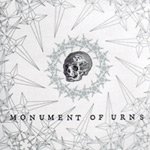First, there is the strike of a piano, methodically repeating the note A. Then what sounds like a faint wind blows, slow and muffled, which, on closer inspection, is revealed as a human voice, whispering long, wordless gasps across your headphones. The hiss is soon augmented by a low, familiar rumble: guitars! They come at you from all sides, nothing more than brutal texture, followed by the first crash of percussion, its unrelenting heartbeat. This is doom metal as represented on Absence, the new 3-inch CD-R from Monument of Urns, their fourth release since 2005. The music writhes, it screams, it crushes.
Doom metal is a relatively new form of music, one we can call our own. It has been with us in similar form since the ’80s, with roots planted long before, but never has the unified vision of the music's potential — and purpose — been accepted by so many across such wide a spectrum. In fact, we can view doom metal as a collective conscious of sorts, not dissimilar from Steve Reich's ‘minimalistic’ movement in the ’60s and onward. An intellectual theme is present in both musics, a manifesto on sound and its relation to our bodies. Practitioners of early minimalism grappled with the urgency of rhythm and repetition, but their aesthetic was really a breakaway from the 20th century's modernist dive into hyper-complex atonal music, bringing music back to the realm of our daily, increasingly mechanized lives and mirroring nature's steady patterns and progressions. Doom metal uses these tactics almost as a rule, resulting in a music of the earth, so to speak: belonging to no one and everyone at the same time.
Interestingly, doom metal only became realized after hordes of bands began doing, essentially, the same thing. An epic cross-cultural variation on a theme. It's curious that in more streamlined rock ‘n’ roll, such similarity between bands is a death knoll. Popular song's reliance on strict form — numbers and equations, really — becomes a limiting factor. By most standards, to be considered pop or rock, a sturdy foundation must be present, while subsequent success depends on the merging of said form with extemporaneous factors, like an urgent performance or other sound dressings. When I listen to Monument of Urns, however, their sameness — the culmination of years of ideas, distilled to their simplest form — is freeing. Their music engages on both a visceral and intellectual level, almost without trying, an effortlessness that happens to indict more manufactured branches of the avant-garde. When you listen to the crunch of doom metal, it seems to rise out of necessity, not theory, positing a different set of intellectual hurdles to cross. How does the music relate to our senses? I think of an upper-crust crowd in Vienna, sitting cold and impatient at The Theatre on the Wien River in 1808, just before Beethoven's Fifth is premiered — Dun dun dun DUUUUN! And it becomes clear: our perception has only changed with the number of exploited decibels.
In the ’70s and ’80s, heavy metal borrowed Romantic-style harmony with modern sounds and timbres. But for millions of listeners, the most important aspect of the music was its primal power, its electricity. Through sheer force, budding teenagers stuck on top 40 radio could migrate to Ministry and Slayer with ease, while jazz usually took a few more years to catch on. I remember sitting in my room, not even past grade school, listening to some nondescript metal song I had taped off the radio. When the guitars strummed down a huge, low chord, I got a feeling in my gut like someone had just killed my dog or pushed my mom off a cliff. It was almost elemental. Now, in 2008, we can consider the connection between two disparate points and realize that the true shared aspect between Beethoven, Schoenberg, Reich, Slayer, Monument of Urns, and the expanding realm of doom metal is the unique ability to literally affect our insides, and to do so without us having to get out of our seat. Monument of Urns are successful because they tap into something urgent and primal within us and within music itself. Again, the urge is not theirs alone, but at this moment in time, it feels completely necessary.
[Releases by Monument of Urns are rare, but you can find some at San Francisco's [Aquarius Records->http://www.aquariusrecords.org] or Providence's [Armageddon Shop->http://www.armageddonshop.com/search.php?label=Hand%20Hewn%20Timbre&PHPSESSID=fb4c7331e0fb2a3bfbfabae20ee9ea79].]
1. Absence
More about: Monument of Urns

